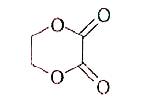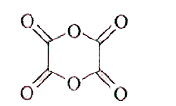When ethylene glycol is heated with a mixture of concentrated HNO3 and concentrated H2SO4, it produces
COOH| COOH
CO2+H2
CH2ONO2| CH2ONO2
CH2ONO2| CH2OH
To solve the question of what product is formed when ethylene glycol is heated with a mixture of concentrated nitric acid (HNO3) and concentrated sulfuric acid (H2SO4), we can follow these steps:
Step 1: Understand the Reactants
Ethylene glycol is a diol with the formula C2H6O2 or HO−CH2−CH2−OH. It contains two hydroxyl (-OH) groups.
Step 2: Identify the Reaction Type
The reaction of ethylene glycol with concentrated nitric acid and concentrated sulfuric acid is a nitration reaction. Nitration typically involves the introduction of nitro groups (-NO2) into an organic compound.
Step 3: Write the Reaction
The reaction can be represented as follows:
C2H6O2+2HNO3H2SO4−−−−→C2H4N2O6+2H2O
Here, ethylene glycol reacts with nitric acid in the presence of sulfuric acid.
Step 4: Determine the Product
In this reaction, the hydroxyl (-OH) groups of ethylene glycol are replaced by nitro (-NO2) groups. Therefore, the product formed is ethylene glycol dinitrate, which has the formula C2H4N2O6.
Step 5: Finalize the Product
The final product of the reaction is ethylene glycol dinitrate, which can be represented structurally as:
HO−CH(NO2)−CH(NO2)−OH
This indicates that both hydroxyl groups have been converted to nitro groups.
Conclusion
When ethylene glycol is heated with a mixture of concentrated nitric acid and concentrated sulfuric acid, the product formed is ethylene glycol dinitrate.
---
Ethylene glycol is a diol with the formula C2H6O2 or HO−CH2−CH2−OH. It contains two hydroxyl (-OH) groups.
The reaction of ethylene glycol with concentrated nitric acid and concentrated sulfuric acid is a nitration reaction. Nitration typically involves the introduction of nitro groups (-NO2) into an organic compound.
The reaction can be represented as follows:
C2H6O2+2HNO3H2SO4−−−−→C2H4N2O6+2H2O
Here, ethylene glycol reacts with nitric acid in the presence of sulfuric acid.
In this reaction, the hydroxyl (-OH) groups of ethylene glycol are replaced by nitro (-NO2) groups. Therefore, the product formed is ethylene glycol dinitrate, which has the formula C2H4N2O6.
The final product of the reaction is ethylene glycol dinitrate, which can be represented structurally as:
HO−CH(NO2)−CH(NO2)−OH
This indicates that both hydroxyl groups have been converted to nitro groups.
When ethylene glycol is heated with a mixture of concentrated nitric acid and concentrated sulfuric acid, the product formed is ethylene glycol dinitrate.
Topper's Solved these Questions
- ALCOHOLS, PHENOLS & ETHERS BOOK - VMC MODULES ENGLISHCHAPTER - ALCOHOLS, PHENOLS & ETHERS EXERCISE - IN-CHAPTER EXERCISE - A
10 Videos
- ALCOHOLS, PHENOLS & ETHERS BOOK - VMC MODULES ENGLISHCHAPTER - ALCOHOLS, PHENOLS & ETHERS EXERCISE - IN-CHAPTER EXERCISE - B
10 Videos
- ALCOHOLS, PHENOLS & ETHERS BOOK - VMC MODULES ENGLISHCHAPTER - ALCOHOLS, PHENOLS & ETHERS EXERCISE - PRACTICE EXERCISE:3
8 Videos
- 13-14 HYDROGEN & S-BLOCK ELEMENTBOOK - VMC MODULES ENGLISHCHAPTER - 13-14 HYDROGEN & S-BLOCK ELEMENTEXERCISE - JEE Advanced Archive
48 Videos
- ALCOHOLS, PHENOLS & ETHERSBOOK - VMC MODULES ENGLISHCHAPTER - ALCOHOLS, PHENOLS & ETHERSEXERCISE - Impeccable
100 Videos
Similar Questions
Knowledge Check
When ethylene glycol is heated with oxalic acid in the presence of conc. H2SO4, the product formed is :
A B
B C
C D
D
Benzene on treatment with a mixture of conc. HNO3 and con. H2SO4 at 373K gives
View SolutionTin reacts with concentrated HNO3 and gives:
View SolutionWhen oxalic acid is heated with concentrated H2SO4 it produces
View SolutionConcentrated H2SO4 can't act as a/an
View SolutionSodium chloride on heating with aqueous solution of K2Cr2O7 and concentrated H2SO4 produces:
View SolutionAnisole with conc. HNO3 and conc. H2SO4 gives
View SolutionAnisole with conc. HNO3 and conc. H2SO4 gives
View Solution
